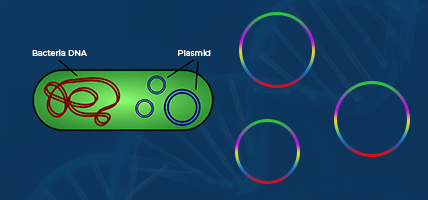


Plasmid term was first acquainted by the American molecular biologist Joshua Lederberg in 1952. In microbiology, genetics and molecular biology, a plasmid is a minute, orbicular but sometimes linear, double-stranded Deoxyribonucleic acid (DNA) molecule that is evident, abstracted form and can imitate independently of the chromosomal DNA. It is found in some eukaryotes (2mm Saccharomyces cerevisiae) and naturally exist in bacterial cells however also found in archaea and other multicellular organisms. By 1960s a number of Plasmids (extrachromosomal hereditary element) had been described which append fertility plasmids initially noticed in the late 1940s by Esther Lederberg. The plasmids generally carry one gene and many of its genes are favourable to their host organism. Despite they have detached genes from their hosts and are not considered to be freewheeling life. Recurrently, the plasmid’s gene caters bacteria with a genetic boon (as antibiotics resistance). Plasmids have broad range of length approximately 5,000 DNA base pairs (bp) and size varies from 1 to 1,000 DNA kilobase pairs (kbp). When bacterium split, all plasmid contained inward the cell are transcribed such that each daughter cell receives transcribe of each plasmid. Bacteria can likewise transmission plasmid to one another over a process called conjugation.
The properties of plasmid make it more useful and are follows:-
1) Each plasmid has its own origin of replication (a stretch of DNA). For this reason, the plasmid can clone themselves separately of the bacterial chromosome. So, there can be numerous copies of it within one bacterial cell.
2) Plasmid helps the bacteria conquer the occasional stressful stage, making the host bacteria resistant to antibiotics (not die when serving with antibiotic).
3) The plasmid enters the bacterial cell easily and is self stimulate extrachromosomal DNA molecule of precise size that is stably inherited and exchanged among an expansive spectrum of bacteria and other domain.
4) They are useful in survival beneath local selective pressure of population samples by horizontal gene pool for the adaptive traits.
5) They provide genetic variation to allow fast gene fixation and act as a source of recombination in new trait abide.
The arrays of plasmid perform numerous functions:-
1) Pumping the metal toxic out of bacteria and bioaccumulation in redox chemistry and compounds by converting it to less toxic ion.
2) Plasmid reconciles arsenic (ars), chromate (Chr), mercury (mer) and cadmium (cad) resistance for gram (-) bacteria and gram (+) bacteria.
3) The plasmid has the ability to fix nitrogen and have a specific function of metabolism allowing a bacterium to utilize nutrients.
The plasmid genes with specific function oppose the extensive amount of non-coding DNA. Diverse plasmids can coincide in the same cell with each different function. The functions are facilitating the details in the section specific types of plasmids below.
There are mainly five types of plasmids:
1) Fertility F- plasmid: The F- plasmid containing transfer gene which allows the gene to transfer from one bacteria to another bacteria by the process of conjugation. The bacteria without F- plasmid is known as F negative (-) and bacteria with F plasmid known as F positive (+) bacteria. In each bacterium, there are only one F plasmids.
2) Virulence plasmid: A bacterium containing the virulence plasmid considered as a pathogen (disease agent). Bacteria causing disease can efficiently replicate and spread amidst affected individuals. An example is E.coli present in the human gut can cause vomiting and diarrhoea.
3) Col plasmid: These contain genes which make colicins (also called bacteriocins) which are proteins that kill other bacteria defending host bacterium. These colicins are found plenty of types of bacteria include E.coli.
4) Resistance plasmid: Also known as R plasmid. Containing genes help bacteria cell to defend environmental factors like antibiotics or poisons.
5) Degradation plasmid:- This plasmid also called a conjugative plasmid that helps the host bacteria to digest compounds (found nature) like xylene, camphor, salicylic acid and toluene. The gene of plasmid comprises of a special enzyme that breakdown distinct compound.
The application of plasmids is immensely worthwhile tools in the fields microbiology, molecular biology and genetic engineering. They play crucial role in recombinant protein production (example human insulin), gene cloning, gene therapy research, artificial plasmid used as vectors in molecular cloning ( serve as decisive tools in biotechnology labs used to amplify and clone or express genes), bacterial cloning vectors ( this vector contains cloning site or polylinker uses restriction that allows DNA fragment to be inserted or ligated), protein production (researchers grow bacteria contains plasmid harbouring gene of interest), DNA vaccines (for HIV-AIDS, Malaria, Ebola, influenza, enteric pathogens and also being used for non-treatable neurological disorder like Alzheimer’s disease, Parkinson’s, multiple sclerosis and ischemic stroke) and uses of plasmids formulated software to record DNA sequence in several different techniques.
The scientists have taken the interest in plasmid as tools for manifold uses like clone, relocation and manipulate gene. The plasmid vectors creating recombinant plasmid for introducing it into the bacteria by the process transformation. Multifarious plasmids have been coined over the year by the researchers and given out database of plasmid such as to non- profit organization. One can identify and request plasmid from a database for scrutinizing. The plasmid sequences are uploaded to the National Centre for Biotechnology Information (NCBI), from which specific plasmid can be retrieved for the research purposes by the researchers.
